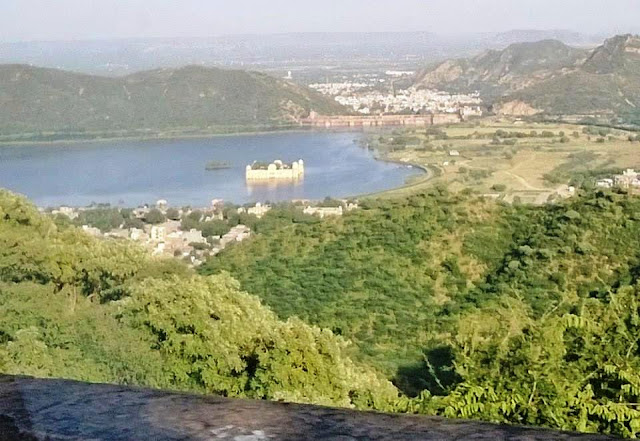Welcome to Chokhi Daani - the Kala Gram or Craftsmen's Village.
While at Jaipur, don't miss this crafts resort. You will hear it from the locals too as a must visit place in the city.
Try the lavish dinner spread on environmental friendly dried leaf plates being served in an open area. It is a sit-down dinner. The food is arranged and served neatly on small cups placed on a small, wooden table. The 'lassi' or buttermilk is served in an earthen pot.

One thing I really like about traditional Indian food is the recyclable plate on which it is served. In the coastal belt of Karnataka (where I come from), we still use plantain leaves.

It is a pleasure to eat on fresh banana leaves or as in most Soutn Indian temples on dried plants leaves strewn together. They are easy to dispose off too. What the world woke up to in the 21st century India has been doing since centuries.
The meal though was totally and boringly
vegetarian. The famous 'daal-baati' was so hard we couldn't break it.
90% of Rajasthanis are vegetarian. The locals told us not to eat non-vegetarian dishes because it is usually not fresh.
The funny part was the circulation of the Rajasthani petas! Everyone got to wear it and got their 'look like locals' moment.

The resort has all kinds of entertainment.
Camel rides, elephant rides, bullock cart rides,
There is tight-rope walking too and a live dance performance of Rajasthani folk dance.
You can join the dancers swirling around in their long, round skirts full of bead and mirror work, the 'ghunghat' nicely placed on their heads.
There are lots of places to shop and eat
But one thing you will realize is almost everyone is prompting you to tip them generously - whether it is the waiter at the open meal counters or the dancers or any of the other entertainers.
The ethnic atmosphere of the village - whether it is in the buildings or the costumes of the different staff or the overall ambiance makes you feel like you are right in the middle of a typical Rajasthani village.
The beautiful model houses dotting the entire property of the Kala Gram is a visual treat to the eyes. You can spend the whole day here - clicking pics, eating, shopping or just relaxing watching others.

While at Jaipur, don't miss this crafts resort. You will hear it from the locals too as a must visit place in the city.
Try the lavish dinner spread on environmental friendly dried leaf plates being served in an open area. It is a sit-down dinner. The food is arranged and served neatly on small cups placed on a small, wooden table. The 'lassi' or buttermilk is served in an earthen pot.

One thing I really like about traditional Indian food is the recyclable plate on which it is served. In the coastal belt of Karnataka (where I come from), we still use plantain leaves.

It is a pleasure to eat on fresh banana leaves or as in most Soutn Indian temples on dried plants leaves strewn together. They are easy to dispose off too. What the world woke up to in the 21st century India has been doing since centuries.
The meal though was totally and boringly
vegetarian. The famous 'daal-baati' was so hard we couldn't break it.
The funny part was the circulation of the Rajasthani petas! Everyone got to wear it and got their 'look like locals' moment.

The resort has all kinds of entertainment.
Camel rides, elephant rides, bullock cart rides,
There is tight-rope walking too and a live dance performance of Rajasthani folk dance.
You can join the dancers swirling around in their long, round skirts full of bead and mirror work, the 'ghunghat' nicely placed on their heads.
There are lots of places to shop and eat
But one thing you will realize is almost everyone is prompting you to tip them generously - whether it is the waiter at the open meal counters or the dancers or any of the other entertainers.
The ethnic atmosphere of the village - whether it is in the buildings or the costumes of the different staff or the overall ambiance makes you feel like you are right in the middle of a typical Rajasthani village.
The beautiful model houses dotting the entire property of the Kala Gram is a visual treat to the eyes. You can spend the whole day here - clicking pics, eating, shopping or just relaxing watching others.

And while you are there, don't forget to have a shot of hookah with this wise, old man.














